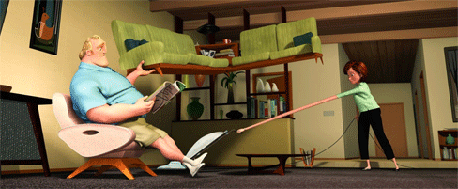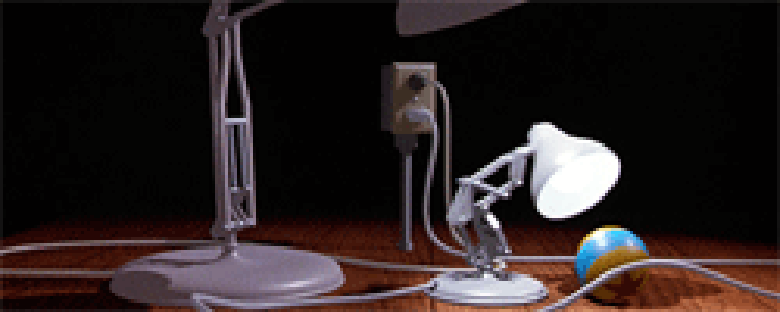Credits
Feature by: Teddy Blanks
Posted on: 17 June 2007
Related articles:
Features: What is Animation?
Nearly every big-budget cartoon of the past five years has been made using computer animation, and we have one production company to thank for that—Pixar. Once a computer hardware company, and now owned by Disney, Pixar is responsible for five of the ten highest grossing animated films of all time. I was still a kid when they released the first full-length computer-animated feature, Toy Story, in 1995, and, perhaps mistakenly, more captivated by its technology than its storytelling.

Pixar had previously addressed the secret lives of toys in Tin Toy, a short from 1988 in which a baby terrorizes a wind-up one-man-band. The small toy is wonderful, its facial structure limited but full of expression. At one point, the toy tries to quietly sneak away from the baby, but can’t repress his percussive mechanics, and he involuntarily produces loud music when he walks. His panic and attempt to stifle the sound are communicated by a glance down at his own arms, which are banging away at cymbals, as if he had no control over them. This kind of care taken to the reactions and expressions of characters is already evident in Pixar’s short films from the late 80s, a time when the mere sight of computer animation was enough to inspire awe. Clever, charming character animation was icing on the cake.
Given their geometric simplicity, toys are an inspired starting point for Pixar, and also for the imagined world they live in, one in which the children that play with them aren’t privy to. In Toy Story, that world is established in a memorable opening sequence in which Sheriff Woody, the most popular with Andy (their owner), leads, via walkie-talkie, a bucket of toy soldiers on a fact-gathering mission downstairs, where Andy is opening his birthday presents. Naturally, the toys are afraid of being replaced by newer, flashier gadgets—which they are, when Andy gets Buzz Lightyear, a Space Ranger action figure. In this world, a toy’s entire sense of worth is based on his relationship with the child that plays with him. The looming message is that it’s only a matter of time before that relationship turns to one of neglect and indifference. (Pixar, it seems, is never afraid to delve into potentially dark psychological territory, be it that of a toy, a talking fish, or a nuclear family of superheroes.)
This small, separate world of toys is only the first of many worlds Pixar has created, including a world of insects in A Bug’s Life, a world of monsters-under-the-bed in Monsters, Inc., an underwater world in Finding Nemo, and a world of talking and self-driving autos in Cars. The only Pixar film that takes place within a physical world comparable in scale and human population to ours is The Incredibles, and its superheroes have their own world, too. Each of these movies contain, somewhere out there, tucked away, entire cultures of creatures, with their own customs, routines, and problems. This idea allows Pixar to explore new environments, types of characters, and animation techniques with each new picture. When it works, we get lost in these worlds; the summer Finding Nemo came out, I was working at a movie theater in a mall – a depressing job – and after my shifts, I would duck into Theater 3, sit in the front row, and pretend I was under the sea with the characters.

In Finding Nemo, every flicker of light on the murky water dazzles, and every splash looks hyper-real. The fins and gills on its fishy characters are tools for gestural expression, and at the same time move in a way that is sophisticated enough to mimic the way real fish swim. Pixar’s worlds even have their own sub-worlds—when little Nemo is captured by humans and taken away from his father, he is put into an aquarium in a dentist’s office in Australia, which is a world unto itself, with its own rules and traditions. With no knowledge of ocean life, the aquarium fish have no context to measure their lives against except the dentist’s feeding schedule and the tank’s plastic landscape mimicry. Naturally, they’ve developed an elaborate belief system based on their captivity and seclusion. In Toy Story, there is a sub-world of little alien dolls, living in an arcade game in an outer-space-themed pizza restaurant. They are all identical, and worship “The Claw,” the metal grabbing mechanism overhead that, every so often, comes to take one of them away to live with the child who has won it.
Following the look of Buzz and Woody, Pixar’s creatures are models of simplicity, with big, circular eyes, and an overall rounded-off feeling. This look is amusing enough to not be boring and flexible enough to be applied to an endless variety of characters. These characters communicate their feelings through their eyebrows and mouths, and especially through their exaggerated, often slapstick body language. The most minimal of the Pixar creatures is Mike Wazowski from Monsters, Inc., basically a green circle with one eye, a toothy grin, and noodle-thin arms and legs. Wazowski, voiced by Billy Crystal, is among Pixar’s funniest and most expressive characters.

Exploring the expressive powers of fins on fish or wheels and headlights on cars allows Pixar to find human qualities in decidedly non-human subjects, but when faced with human, (or rather, super-human) characters for The Incredibles, they solve an entirely new set of problems. In a non-Pixar movie like Shrek, the human characters look too much like real humans, and not enough like cartoon characters. If you’re going to create an almost-human human character in an artificial 3D space, why not just film a real actor in front of a blue screen? It’s true that CGI is now sophisticated and mathematical enough to reproduce lifelike skeletal structures and capture details down to the dirt in each pore. Yet the closer to reality its imagery gets, the more disingenuous and phony it seems. Shrek’s humans are impressive, studied, scientific things, but they look more realistic than cinematic—they have no character. In contrast, Pixar’s humans are as expressive and cartoonish as their fish.
The characters and environments in a Pixar film relay light and shadow as if they were real objects shot with a movie camera, instead of looking freshly processed through a computer. Take a look at the harsh, unstudied cinematography (as, seemingly in a three dimensional world, we must refer to it as such) of Over The Hedge or Madagascar, two recent Dreamworks movies. The camera and lights in their films seem to be set on default, roaming around their 3D environments clumsily, often arbitrarily shooting their subjects. Pixar takes more care in the framing, editing, and artistry of their films. In Ratatouille, a film about a rat who would be a gourmet chef if he weren’t a rat, there is a chase sequence in which Remy (the rat) exhausts all of the possible hiding places for a rodent in a Paris kitchen. It’s all zooms, elaborate tracking shots and POV.s, and zero dialogue, a triumph of timing and scale. Before he escapes, he stops for a moment, and we see a far shot of him from the rim of a pot of boiling soup, pausing to look back, unable to resist the urge to meddle with the just-in-reach spices and ingredients to improve the flavor of the soup.

In Toy Story, in plain view on Andy’s shelves are books with titles like “Tin Toy,” “Luxo, Jr.,” “Red’s Dream”—all names of the early Pixar shorts. In Cars, there is a scene during the credits that takes place in a drive-in movie theater (the only kind of movie theater cars can go to, I guess), where the Cars characters watch versions of A Bug’s Life and Monsters, Inc. with all-car casts. This self-referencing is part in-joke and part branding: even the lamp from their first short film, Luxo, Jr., ended up a mainstay, now stomping out the “I” in the company’s pre-film motion logo before every Pixar film. But despite the constant reminder in Pixar’s films of exactly which other computer-animated kids movies Pixar has produced, the brand has become somewhat ubiquitous. In the same way that Xerox equals copy and Kleenex equals tissue, Pixar has come to equal computer animation itself. (A search for “Pixar” on YouTube yields a myriad of amateur short films that have been wrongly attributed to the company.)
Except for Rataouille and The Incredibles, both penned singularly by Brad Bird, Pixar’s movies are written in teams, and, contrary to common too-many-cooks perception, they seem to thrive from the collaborative effort. What if there was a twelve-step meeting of friendly sharks who are eliminating fish from their diets? How do the toys of an action figure-torching twelve-year-old cope with living, mangled, in the bedroom of a sadist? One walks away from Toy Story or Finding Nemo feeling that they really have thought of everything, and the clever details that make up these worlds are anchored by fully-drawn characters and solid storytelling. Other than possibly Bambi, I can’t think of another kids movie as devastatingly effecting as Finding Nemo. A little fish is caught by a fishing boat and separated, literally oceans away, from his overprotective, widower father. It’s about fear, death, and hope, and if you let yourself be taken in by its necessarily conventional morality, it can be touching, even poignant. Even in the few Pixar movies, like Cars, whose stories are unremarkable or clichéd, the writers’ sheer love for their subjects shines through. In that movie, the reverence and fondness shown for racing and the pre-interstate highway system is so pure, it’s hard not to get choked up.
David Denby wrote of Dreamworks’ Shrek The Third: “The Shrek phenomenon is one of those seeming oddities in our culture—children being entertained with derision before they’ve been ravished by awe.” The stale formula, after a decade of computer animation, is that kids’ movies are peppered with sexual innuendoes and pop cultural references so that lazy commentators can write, “there’s something for the whole family to enjoy.” Most of Hollywood is convinced that these are the best kinds of children’s movies: ones that can work first on a kid’s level, and second on an over-their-head adult’s level, which references TV shows and sex and uses familiar star voices, perpetually winking at us. But the truth is that the for-parents jokes are usually about as crude as the obligatory fart jokes are for the kids. Pixar, on the other hand, makes kids’ movies that appeal to everyone for the same reasons: lovable characters, artful animation, and humor that is organic to the subject of the movie. Their unwavering, 40-year-old-virgin credo that we’re all kids at heart is only bearable because they are so devoted to what they do, and if they’re sometimes too earnest, it’s better than cynicism.
In his condemnation of cartoons for the cell-phoned tween set, Denby is getting at something, but it goes further than the bastardization of fairy tales into irony and sarcasm in Shrek. Movies made for children become classics only when they eschew irony in favor of earnestness. If we want all the trappings of adult comedy performed by big stars, there are always plenty of options. But Pixar provides something that the competition doesn’t: the chance to remember how to watch movies as children, with big, open eyes.
We don’t do comments anymore, but you may contact us here or find us on Twitter or Facebook.



